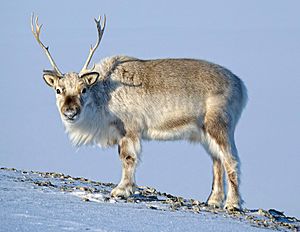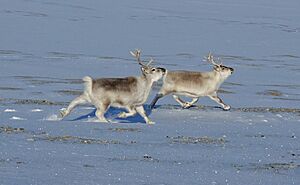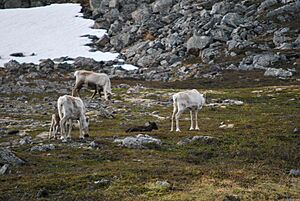Svalbard reindeer facts for kids
Quick facts for kids Svalbard reindeer |
|
|---|---|
 |
|
| Svalbard reindeer | |
| Conservation status | |
| Scientific classification |
|
| Kingdom: | Animalia |
| Phylum: | Chordata |
| Class: | Mammalia |
| Order: | Artiodactyla |
| Family: | Cervidae |
| Subfamily: | Capreolinae |
| Genus: | Rangifer |
| Species: | |
| Subspecies: |
R. t. platyrhynchus
|
| Trinomial name | |
| Rangifer tarandus platyrhynchus (Vrolik, 1829)
|
|
The Svalbard reindeer (Rangifer tarandus platyrhynchus) is a special kind of reindeer. It is a small subspecies that lives on the Svalbard islands in Norway. These reindeer are much smaller than other reindeer. Male Svalbard reindeer weigh about 65 to 90 kilograms (143-198 pounds). Females are a bit lighter, weighing 53 to 70 kilograms (116-154 pounds).
These unique reindeer have lived on the Svalbard islands for at least 5,000 years. They have learned to live well in the very cold Arctic climate. You can find them in almost all areas of the islands that are not covered by glaciers. In the past, around 1925, there were very few left because too many were hunted. Luckily, their numbers have grown a lot in recent years. By 2019, there were about 22,000 Svalbard reindeer across the islands.
They are the only large plant-eating mammal in the European High Arctic. This makes them important for scientists studying how pollution affects changing environments. During the short Arctic summer, they eat lots of plants like grasses, herbs, and small bushes. They do this to build up fat for the long, cold winter. Their fur even contains tiny bits of chemicals from the plants they eat. Svalbard reindeer do not move around much. This means they are very sensitive to changes in their local environment.
What Do Svalbard Reindeer Look Like?
Compared to other reindeer, Svalbard reindeer have shorter legs. They also have a small, rounded head. Their fur is lighter in color and much thicker during the winter months. This thick fur makes them look short-legged and even makes thin reindeer appear plump in winter.
Antlers: A Special Feature
Male reindeer grow large antlers between April and July. They shed the soft, furry skin on their antlers, called velvet, around August or September. Males usually lose their antlers in early winter. Female reindeer start growing their antlers in June. They typically keep their antlers for a whole year.
How Climate Change Affects Reindeer
In July 2019, about 200 reindeer were found to have died because they could not find food. This happened because of warmer temperatures caused by climate change. Rain fell early in the winter, and then it froze, creating thick layers of ice on the ground. This ice covered the plants, making it impossible for the reindeer to reach their food. This event shows how sensitive these animals are to changes in their environment.




